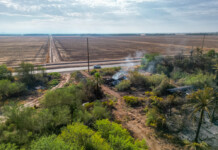
Charles M. Clark is not recognized as one of Pinal County's prominent historical figures. However, some of his stories, which were published in 1929 in the Arizona Republican, give great insight into life in Arizona in the 1870s.
Clark came to Arizona as a military telegraph operator and he was the first operator at Maricopa Wells in the early 1870s. He was only 17.
The Wells had been long established as a trading station along the Gila River. In 1858 the Butterfield Overland Stage Mail Line was given a government contract to haul mail from St. Louis, Missouri, to San Francisco, California. A station was built at the Wells to accommodate the stagecoach and its customers.
When Clark arrived at Maricopa Wells, traffic from throughout the West was a consistent mix of American culture. However, a culture unto itself was well established and delineated at the station.
The family of the station manager sat down for each meal with a white tablecloth covering their end of the long table. Clark describes the rest of the table, where the guests and staff ate, being covered by "a well-worn oilcloth of vintage of 1864–crushed, cracked and darkened by use and abuse to a dull black."
The flies were so thick that a worker was stationed outside the adobe building to manhandle a contraption used to keep the flies away from the diners. An iron bar, which extended through the eaves of building, was tied with “successive loops of faded, dirty calico, bolt width, dropping to within ten or twelve inches from the top of the table."
The noise that the bar made and the motion of fabric made little difference according to Clark. The flies continued to molest the diner.
After Clark, in an act of defiance to the station manager's wife, sat down one day on the family's end of the table, he was banned from the dining room.
So, he took to cooking his own food. He supplied the gun and ammunition to a Maricopa Indian sharpshooter who would return with game and one less bullet for each item he shot. The hunter earned the nickname, Mata Pato or duck killer, for his skill.
Soon the station manager's wife, jealous of the feast on which Clark was dining and his pie-making skills, told Clark he was welcome back at the station table.
The manager's wife, Jane Moore or 'Aunt Jane from San Berdoo,' was a force with which to be reckoned. "She lived hard and worked hard," according to Clark. He once saw her chase a "Big Missourian" out of her corral with a huge axe and throw his shotgun after him.
A copy of a manuscript found at the Casa Grande Historical Society tells of a good trade of "rich ore" from mines far south of the Gila Valley. The native tribes knew of quantities of ore to the south, but, Clark says, "I only know of one case in Arizona where an Indian showed the location of rich minerals to a white man."
In 1876, after a stint in the U.S. Military Telegraph office in Phoenix, Clark was sent to the telegraph office in Florence because an epidemic of smallpox had hit hard and left the local operator stricken. Once in Florence, Clark was inundated by two weeks of backed up business.
Four days after Clark's arrival in Florence the former operator died. Other sufferers were, according to Clark, covered with so many sores that they were, "black as tar." They also "lost their hair, eyebrows and mustaches."
There were 400 cases of small pox, according to Clark, but only four deaths. Two doctors worked day and night to care for the ill.
Clark, having been vaccinated, jumped into the fray and helped as he could. However, Clark soon came down with the dreaded disease.
One day while recovering on a cot in the telegraph office, a man shouted through the office glass that he wanted an urgent message sent to San Francisco. Clark got up from his cot and began the transaction.
When giving the man back his change from the transaction, the man noticed Clark's condition. "Hell," the man yelled, "you have got small pox. Rush that message and keep the change."
Clark says in his manuscripts that during the five or six days that he worked in the office during his illness his tips increased because people didn't want their change. He soon recovered and lived a long life, remaining in Arizona.
A collection of Clark’s memoirs can be found at the Arizona Historical Society, the Casa Grande Valley Historical Society and in the book, “Reflections of a Desert Town” by Patricia Brock.




![Maricopa’s ‘TikTok Rizz Party,’ explained One of several flyers for a "TikTok rizz party" is taped to a door in the Maricopa Business Center along Honeycutt Road on April 23, 2024. [Monica D. Spencer]](https://www.inmaricopa.com/wp-content/uploads/2024/04/spencer-042324-tiktok-rizz-party-flyer-web-218x150.jpg)



![Locals find zen with Earth Day drum circle Lizz Fiedorczyk instructs a drum circle at Maricopa Community Center April 22, 2024. [Brian Petersheim Jr.]](https://www.inmaricopa.com/wp-content/uploads/2024/04/PJ_3922-Enhanced-NR-218x150.jpg)




![Maricopa restauranteur makes Food Network connection [Namkeen Dhaba]](https://www.inmaricopa.com/wp-content/uploads/2024/04/439456716_377105198650519_7536248579664805896_n-100x70.jpg)


